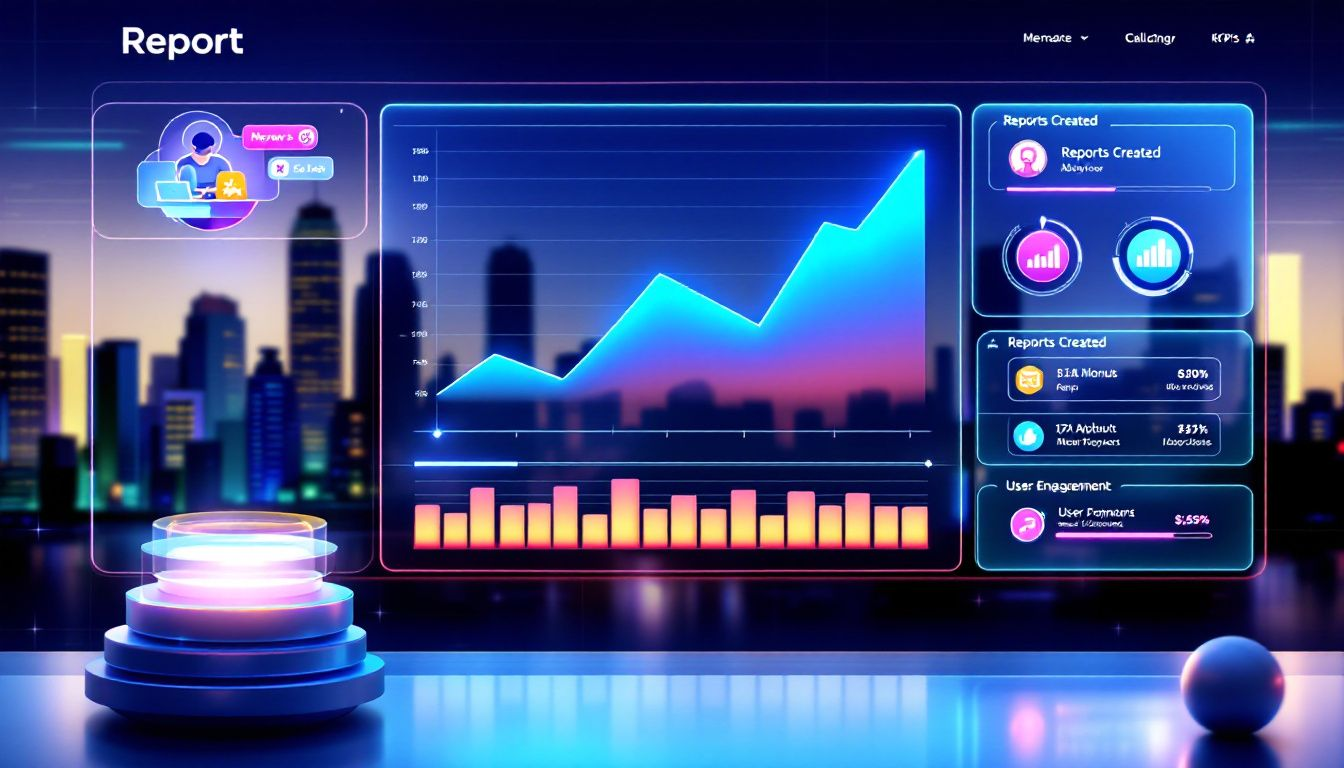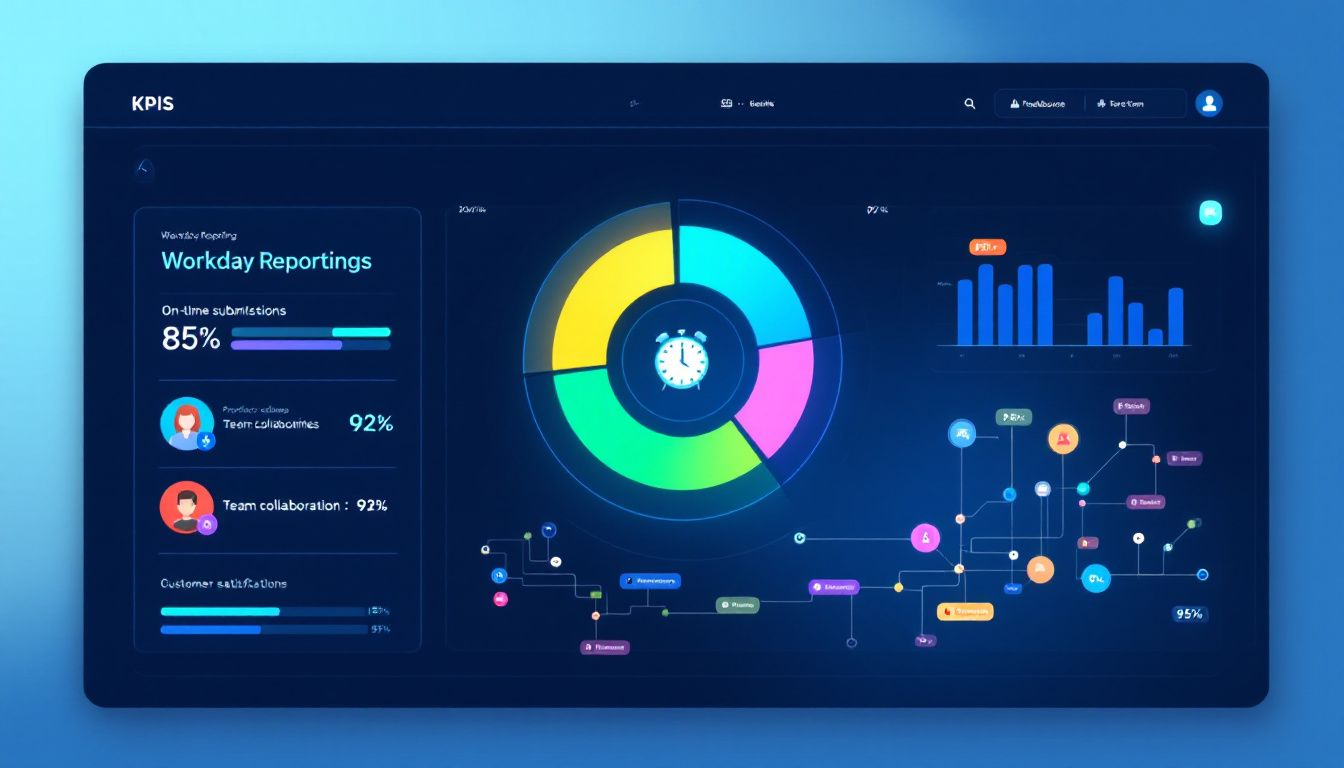Workday Custom Reports empower organizations to unlock deeper insights by tailoring analytics to their unique business needs. Unlike standard reports, custom reports allow users to define specific data sets, apply filters, and create visuals that align with their organizational goals.
In this article, we explore the key features of Workday Custom Reports, how they enhance data accessibility, and a few best practices for creating impactful reports that drive results.
Key Takeaways
- Workday offers various custom report types, including Simple, Advanced, Matrix, and Composite reports, each designed to meet specific organizational needs.
- Effective custom reports involve clear objectives, reliable data sources, uncluttered design, and user-friendly visualizations to ensure data accuracy, integrity, and consistency.
- Utilizing Workday’s built-in reporting tools, such as Report Writer and BIRT integration, along with scheduling and automation features, helps users enhance report depth and efficiency.
Getting Started with Workday Custom Reports

Custom reports enable companies to tailor data collection, management, and presentation to meet specific organizational needs. Workday offers a robust platform for generating tailored reports, helping businesses improve their critical operations by providing valuable insights that improve decision-making across various functions. Understanding the different report types available in Workday enhances the user’s capacity to utilize reporting features effectively.
Workday supports several types of reports, including standard, custom, composite, and advanced reports, allowing businesses to gain critical insights into critical data sources, make defensible choices, and enhance operational and financial performance. Workday’s customization options facilitate real-time decision-making, further enhancing productivity and effectiveness.
Workday’s Reporting library offers customizable solutions, simplifying the process of producing bespoke reports tailored to specific organizational needs. Workday’s advanced reporting functionality is essential for effective data analysis and aids in making informed decisions. Whether you need detailed financial reports or basic operational reports, understanding how to leverage Workday’s reporting tools is key to maximizing their potential.
Steps to Create Custom Reports in Workday
Creating custom reports in Workday involves several key steps, including selecting the appropriate report types and data sources, defining the report fields, adding filters, and customizing report outputs. Each step is vital for generating accurate, insightful reports tailored to your specific business needs.
Here’s a closer look at each one:
Selecting Report Types and Data Sources
Choosing the appropriate report type and data source forms the foundation for effective custom reports. Workday offers various report types, including Tabular, Matrix, and Composite, each enabling users to meet specific organizational and reporting needs.
Users can designate data sources like ‘All Active and Terminated Workers’ to ensure the report draws from relevant, accurate data. When choosing data sources, consider primary business objects and relevant metrics to ensure the generated insights are significant and actionable.
Defining Report Fields and Layout
After selecting the report type and data source, define the relevant report fields and layout. Ensure the fields added to the custom report align with its objectives. Clear objectives guide the selection of relevant data sources and design elements, resulting in effective, tailored reports.
Adding Filters and Prompts
Adding filters and prompts refines the data displayed in the report. Filters limit data based on specific criteria, enhancing the relevance, accessibility, and usability of critical reports.
Including multiple prompts and filters within a single report field allows for more specific data refinement, ensuring the report provides the most relevant and actionable insights.
Customizing Report Outputs
The final step in creating custom reports in Workday is customizing the report outputs. This involves adding logos, colors, fonts, and interactive elements to enhance clarity and attractiveness.
Workday’s customization options allow users to present data in visually appealing and easy-to-interpret ways, enhancing the report’s overall effectiveness and readability for users across all levels.
Types of Custom Reports in Workday
Workday offers various custom report types to meet different business needs, including simple, advanced, matrix, and composite reports. Understanding each report type and its applications across the workforce helps create more effective and insightful reports.
Simple Reports
Simple Reports in Workday focus on raw data from a single business object, offering straightforward data without complex calculations. They are ideal for scenarios requiring straightforward data without complex calculations. The Report Writer tool in Workday allows users to create these reports using templates, ensuring a user-friendly and efficient process.
Advanced Reports
Advanced Reports offer complex features for filtering, grouping, and summarizing employee data for in-depth analysis. Integrating BIRT allows for the development of customized advanced reports with dynamic data and specific formatting, facilitating detailed data analysis and strategic planning.
Matrix Reports
Like pivot tables, Matrix Reports organize and analyze data in rows and columns. This structure helps uncover organizational patterns and trends, making them useful for strategic planning and performance analysis.
Composite Reports
Composite Reports combine multiple reports with different data sources and layouts, providing a complete picture of company operations. They are especially useful for analyzing complex data relationships and gaining deeper insights into executive dashboards and performance summaries.
Best Practices for Effective Workday Custom Reporting

Creating effective custom reports in Workday requires adhering to best practices, such as defining clear objectives and considering your audience. These key best practices ensure that the reports are accurate, relevant, and easy to interpret for users across the entire Workday landscape.
Define Clear Objectives
Defining clear objectives helps users identify relevant data sources and format report designs to convey critical information effectively. They also guide the selection of relevant data sources and layouts for effective reporting, which directly impacts the quality and clarity of the generated reports.
Choose Reliable Data Sources
Choosing data sources aligned with report goals enhances the accuracy and relevance of insights. To meet critical data needs, identify data sources, update frequency, and historical data requirements. Tailored language and visuals also make reports more accessible to users with varying expertise levels.
Keep Design Uncluttered
Uncluttered report designs enhance focus and comprehension, offering a straightforward way for users to process and interpret the information. Limiting the number of fields in each report can reduce load times and facilitate a more efficient reporting experience.
Utilize Visualizations
Choosing appropriate visualizations enhances the interpretation of complex data. Discovery boards in Workday enable users to perform ad hoc analysis with an intuitive drag-and-drop interface. Effective visualizations significantly improve the understanding of complex datasets across Workday systems.
Test and Validate Reports
Testing and validating reports ensures critical accuracy and reliability requirements are met. Gathering stakeholder feedback during the testing phase is crucial for ensuring accuracy and usability. Integrating feedback into report revisions enables continuous improvement and enhances overall report quality.
Consider Your Audience
Considering your target audience ensures the report is understandable and relevant to users with varying knowledge levels. Sharing custom report outputs with specific groups and users enhances accessibility and relevance.
Additionally, offering comprehensive training resources like in-person training sessions, video tutorials, and quick reference guides is crucial for effective user adoption and effective report management.
Enhancing Custom Reports with Workday Reporting Tools
Workday provides several reporting tools to enhance custom reports, including the Report Writer tool, BIRT integration, and scheduling and automation features. Here’s a closer look at a few key tools:
Report Writer Tool
The Workday Report Writer tool facilitates the construction of simple direct reports using templates and is user-friendly. It supports the immediate execution of Report Writer reports from any application interface, making it convenient for generating quick insights. Additionally, the Report Designer feature offers advanced reporting capabilities and flexibility but requires more advanced technical knowledge.
BIRT Integration
BIRT integration in Workday enables the creation of detailed reports with comprehensive features. This tool allows users to incorporate complex features and customizable options, enhancing report depth, detail, and level of complexity.
Scheduling and Automation
The ability to schedule reports helps organizations streamline core reporting processes, ensuring timely access to crucial data. Automating report generation reduces manual errors, saves time, and increases organizational efficiency.
Workday’s advanced reporting tools allow users to specify the frequency and timing of report generation, ensuring core reporting capabilities are always up-to-date in the Workday system.
Common Challenges and Solutions in Workday Custom Reporting

Creating custom reports in Workday presents several challenges, from data accuracy issues to performance optimization and comprehensive user training. Understanding these challenges and their solutions is critical to maintaining efficient and effective reporting processes.
Data Accuracy Issues
Data accuracy in custom reports influences decision-making, reporting credibility, and overall data effectiveness. Inaccurate data can lead to misguided analytics, affecting business outcomes and strategic planning. Choosing accurate data sources and report parameters significantly affects the reliability of custom reports.
Implementing validation processes ensures the data used in reports remains accurate and trustworthy. Regular audits and reviews of report content help identify discrepancies and maintain data integrity. Automated testing tools can also streamline the verification process and reduce the likelihood of errors.
Performance Optimization
Understanding the key factors contributing to report load times is crucial for optimizing custom reports. Efficient data sources, report formats, and filters can significantly reduce load times, narrow the data processed, and improve performance.
Reports are regularly tested and validated to identify performance bottlenecks and improvement opportunities. Additionally, user feedback is gathered after implementation to ensure that reports meet performance expectations.
User Training
Data accuracy and integrity in custom reports are crucial for effective report creation and decision-making. Establishing clear objectives before creating custom reports helps users tailor the training process to specific organizational needs and improve report relevance.
Tailoring reports to the target audience’s needs and comprehension levels enhances training effectiveness. Validating and testing reports ensures feedback gathering and accuracy, improves user training, and enhances overall report performance.
Get Started with Workday Experts
Whether you need help outlining requirements for a new Workday implementation project, additional support navigating complex integrations between Workday and non-Workday systems, or an extra hand maximizing the potential of your existing Workday reporting capabilities, Surety Systems can help.
Our senior-level Workday consultants have the skills and experience to handle your critical project needs and ensure your internal teams are prepared for continuous improvement and innovation.
Contact Us
For more information about our Workday consulting services or to get started on a project with our team of expert consultants, contact us today.
Frequently Asked Questions
Can you create custom reports in Workday?
Yes, you can create custom reports in Workday using the Report Writer tool. This customization is designed to effectively cater to functional users and allows for a user-friendly experience and the ability to display reports as applications.
How many types of reports are in Workday?
Workday includes two primary types of reports: standard reports, which are delivered with the system, and custom reports, which can be tailored using the Report Writer tool. This structure allows users to access similar data through different reporting options.
What custom report type is the most common Workday?
Workday’s most common custom report type is the Advanced report, accounting for approximately 90% of reports generated.
What are the benefits of using custom reports in Workday?
Using custom reports in Workday allows businesses to tailor data collection and presentation, which enhances decision-making and improves overall productivity. This capability ensures that organizations can effectively address their unique requirements.




